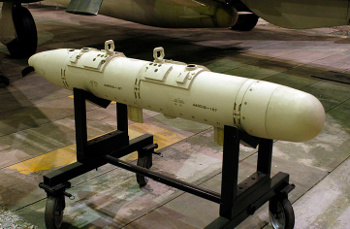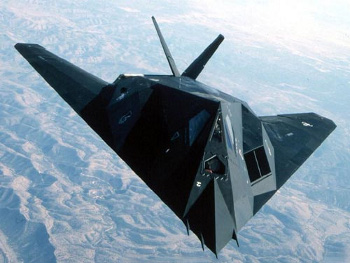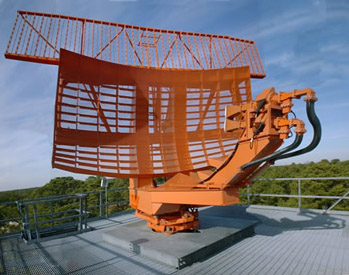Passive Radar
February 22, 2013
Before
broadcast digital television and
cable television, everyone received
analog television signals from just a few
broadcast channels. Most of
my generation will remember what would happen to the
video signal when an
aircraft flew nearby.
NTSC video was
amplitude modulated, so
reflected signals from the aircraft would lead to
multipath reception that would cause the image to
ghost or
roll. The
audio was usually unaffected, since it was a
frequency modulated signal.
Detection of an aircraft through the reflection of signals from a remote
transmitter is one type of
radar.[1-4] Such
bistatic radar systems are unlike conventional,
monostatic radar, which has the transmitter and
receiver sited at the same place, usually using the same
antenna system.[1] Conventional radar systems transmit
pulses of
electromagnetic radiation, and the transit time of these pulses gives the
range to the aircraft.

The Vietnam War era AN/ALQ-71 electronic countermeasures pod was succeeded by the AN/ALQ-99, soon to be replaced by the "Next Generation Jammer."
(U.S. Air Force photo, via Wikimedia Commons.)
Electronic countermeasure (ECM) systems, attached as "pods" on
military aircraft, transmit
random pulses to confuse such
rangefinding (see photo). There are escalating tricks, such as coded pulses and
frequency-hopping, that make ECM systems harder and harder to design. As a consequence, money has been spent on
stealth technology, instead.
Stealth aircraft are designed with a surface topography that reflects very little radiation back to a radar set.
The first stealth
fighter, the
F-117, was a strange looking bird with flat surfaces at all angles in what would seem to be the
Frank Gehry interpretation of what an aircraft should look like. The design was selected to bounce monostatic radar signals away from the aircraft. As a result, the F-117 had only a hundredth the
radar cross-section of a conventional fighter aircraft.
Advanced manufacturing techniques allowed subsequent stealth aircraft, such as the
F-22, to have a more contoured shape.[1]

The first stealth technology fighter, the Lockheed F-117.
(U.S. Air Force photo, via Wikimedia Commons.)
Stealth technology did come with some inherent limitations. You still need
engines to fly, and these emit
heat, which can be detected. The craft are still
optically visible, so missions are limited to night; and, stealth
pilots can't use their own radar or radio systems in combat.[1] Bi-static
passive radar appears to be another way to defeat stealth technology.[1-3]
As often happens with
military technology, an expensive technology such as stealth is often trumped by an inexpensive countermeasure. In the case of stealth aircraft, it's passive radar, and not because passive radar is new.
Robert Watson-Watt, who demonstrated the essential radar idea in 1935, detected a
bomber aircraft at twelve
kilometers using reflected signals from a
BBC shortwave transmitter at
Daventry.[4]
Massachusetts Institute of Technology Aeronautics and Astronautics professor,
John Hansman, was quoted in a 2001 MIT publication as saying,
"Some stealth aircraft, like the F-117, are specifically designed to have a low radar cross section to monostatic, or conventional, radars. They are not stealthy to some bi-static configurations."[1]
In 2001,
Roke Manor Research, at that time a division of
Siemens, announced that it had developed a system for aircraft detection using
mobile phone base stations as both transmitters and receivers.[1] This is significant, since
cellphone towers generally blanket populated areas; and, since they are already deployed, you wouldn't need to pay for most of your passive radar system. Signal strength is not high, but any aircraft would be quite close to at least some cellphone towers, although the signals could be jammed like any others.[1]
Going back to the original Watson-Watt idea,
Lockheed experimented with its
Silent Sentry system that used signals from radio and television broadcast stations on
VHF frequencies.[1] Such stations broadcast powerful signals, often with
effective radiated powers approaching a
megawatt. The smaller number of transmitters makes signal analysis easier, and the high powers make effective jamming much less likely. Such a system is also contemplated by
Cassidian, a division of the
European Aeronautic Defence and Space Company (EADS).[3]
Lest we always focus on
the dark side, there are also
civilian applications of passive radar technology. The Cassidian system has been proposed as an
air traffic control radar system, and it's being demonstrated at the
Stuttgart Airport.[3] Such bi-static systems are easier to deploy and
maintain.[3]

The antenna portion of the ASR-9 Airport Surveillance Radar system.
Note the horn feeds connected by waveguides.
(US Federal Aviation Administration photograph via Wikimedia Commons.)
The passive radar approach has been proposed also by
Thales for the air traffic control application in
Britain. The idea there is to release the radar
spectrum for other uses, such as
mobile communications, now up to "
5G" performance.[4] The Thales two year feasibility study, which also involves Roke Manor, will use signals from television transmitters.[4]
Enabling technologies for this approach are
computer signal processing systems, often reducible to
single-purpose chips, and inexpensive
electronically-steerable antennas. The system should be able to measure location and speed, the latter through
Doppler shift, perhaps more reliably than the present monostatic radar system.[4] Perhaps this would be one reason to keep broadcasting alive in an
Internet world.
References:
- Tao Yue, "Detection of the B-2 Stealth Bomber And a Brief History on 'Stealth'," The Tech, vol. 121, no. 63 (November 30, 2001).
- Arend G. Westra, "Radar versus Stealth - Passive Radar and the Future of U.S. Military Power," Joint Force Quarterly, Issue 55 (Quarter 4, 2009), National Defense University (PDF File). Text only version, from The Free Library.
- Ian Steadman, "'Passive radar' could render stealth planes obsolete," Wired (UK), October 1, 2012.
- Steve McCaskill and Peter Judge, "Air Traffic Control Systems Could Ditch Radar And Release 5G Spectrum," Tech Week Europe, February 13, 2013.
- Airport Surveillance Radar (ASR-11), US Federal Aviation Administration Web Site.
Permanent Link to this article
Linked Keywords: Broadcast digital television; cable television; analog television; signal; broadcasting; broadcast channel; baby boomer; video; aircraft; NTSC; amplitude modulation; amplitude modulated; reflection; multipath; ghost; jitter; roll; audio signal; frequency modulation; frequency modulated; transmitter; radar; bistatic radar; monostatic radar; receiver; antenna; pulse; electromagnetic radiation; range; Vietnam War; AN/ALQ-99; Next Generation Jammer; United States Air Force; Wikimedia Commons; electronic countermeasure; military aircraft; random; rangefinding; frequency; stealth technology; stealth aircraft; fighter; F-117; Frank Gehry; radar cross-section; Advanced manufacturing technique; Lockheed Martin F-22 Raptor; Lockheed; gas turbine engine; heat; optics; optical; aviator; pilot; passive radar; military; technology; Robert Watson-Watt; bomber; kilometer; BBC World Service; shortwave radio; Daventry; Massachusetts Institute of Technology; Aeronautics and Astronautics; professor; John Hansman; Roke Manor Research; Siemens; mobile phone; base station; cellphone tower; Silent Sentry; very high frequency; VHF; effective radiated power; megawatt; Cassidian; European Aeronautic Defence and Space Company; EADS; the dark side; civilian; air traffic control; Stuttgart Airport; maintenance, repair, and operations; Airport Surveillance Radar system; horn antenna; horn feed; waveguide; Federal Aviation Administration; Thales Group; United Kingdom; Britain; frequency allocation; spectrum; mobile communications; 5G; enabling technology; computer signal processing system; signal processor; single-purpose chip; phased array; electronically-steerable antenna; Doppler effect; Doppler shift; Internet.